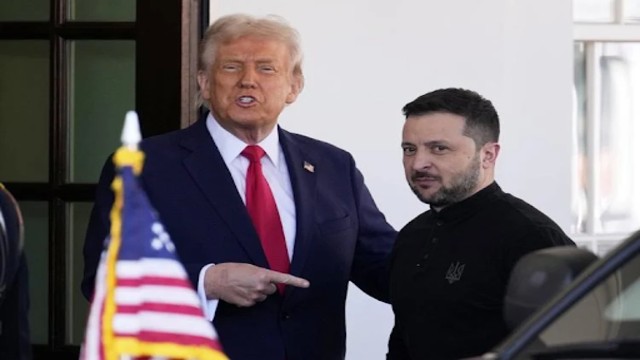
U.S. Secures Ukraine’s Critical Minerals in Bold New Deal to Counter Russia. President Donald Trump and Ukrainian President Zelenskyy at the White House. Feb. 28, 2025. (AP Photo)
In a landmark move, the United States (U.S.) and Ukraine have finalized a strategic deal granting Washington access to Kyiv’s critical minerals. This agreement is expected to boost Ukraine’s post-war recovery and solidify long-term U.S. military support against Russian aggression.
Ukraine Secures Better Terms Than Before
Ukrainian officials describe the new agreement as more favorable than previous drafts. Earlier versions had reduced Ukraine to a secondary role, offering the U.S. sweeping control over vital resources. Now, Ukraine claims to have achieved equal footing.
The agreement, which still awaits ratification by Ukraine’s parliament, also lays the foundation for a joint reconstruction fund. This fund aims to drive investment, particularly in resource development, and ensure future American defense support.
Reconstruction Fund Aims to Power Economic Recovery
Ukraine’s Economy Minister, Yulia Svyrydenko, signed the deal on Kyiv’s behalf. She highlighted that the U.S. formally recognized Ukraine’s role in global peace by surrendering its nuclear weapons. The reconstruction fund will be co-managed by both nations.
The U.S. contribution includes direct funding and defense equipment, notably air defense systems. Ukraine will invest 50% of future profits from state-owned resources into the fund. For the first 10 years, profits will be reinvested, not withdrawn.
New Resources, No Old Debts
Importantly, the deal applies only to resources not already generating state revenue. It excludes any clauses requiring Ukraine to repay past aid. Officials insist Ukraine will retain full ownership and rights over its natural assets.
The agreement covers 55 critical minerals, with the possibility of more being added later. These include rare earth elements, titanium, lithium, and uranium. All are essential for modern technologies and are in high demand globally.
Rare Earth Elements: A Global Power Game
Rare earth elements are vital to producing smartphones, batteries, and electric vehicles. Currently, China dominates global production, prompting the U.S. and its allies to reduce reliance on Beijing.
The inclusion of minerals like lanthanum, cerium, and scandium in the deal highlights the geopolitical significance. For Trump’s administration, securing alternative supply lines aligns with broader strategic goals.
No Exploitation, Just Cooperation
Past U.S. proposals included demands for $500 billion in profits from Ukraine’s mineral industry. Ukrainian President Volodymyr Zelenskyy flatly rejected this. He refused any agreement that would financially burden future generations.
Instead, the final deal ensures that profits benefit Ukraine’s reconstruction and economic future. Svyrydenko emphasized that no external party will dictate what Ukraine extracts or when.
Untapped Potential Amid War Challenges
Ukraine holds some of Europe’s largest reserves of titanium and lithium. However, much of the country’s resource potential remains undeveloped. War, outdated regulations, and poor geological data have all hindered exploration.
Experts note that 40% of Ukraine’s mineral resources are currently inaccessible due to Russian occupation. The urgency to develop what remains is rising, especially before further advances by Russian forces.
This Ukraine-U.S. Deal is a Strategic Message to Russia
U.S. Secretary of State Marco Rubio called this week “critical” for pushing peace efforts forward. Treasury Secretary Scott Bessent said the agreement sends a strong message to Moscow about America’s commitment to a sovereign and prosperous Ukraine.
This deal is more than economics—it’s a strategic partnership for peace, development, and resilience in the face of war.















